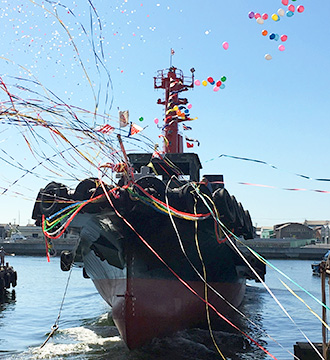- JP
- EN
LNG-fueled Tugboat Named Ishin
-Earns Highest 4-star for Coastal Ship Energy Conservation Rating-
September 28, 2018


At the launching ceremony
TOKYO-Mitsui O.S.K. Lines, Ltd. (MOL; President & CEO: Junichiro Ikeda) today announced that naming and launching ceremonies for the company's LNG-fueled tugboat (*1), built at Kanagawa Dockyard Co., Ltd. (President: Takehito Ikoma, headquarters: Hyogo-ku, Kobe), were held on September 28. The tugboat was named Ishin after the name of MOL's technology development project, the "ISHIN NEXT - MOL SMART SHIP PROJECT –. " Ishin, slated for delivery in February 2019 after the completion of outfitting work, will be the first LNG-fueled tugboat serving Osaka Bay starting in April.
In addition, Ishin's excellent environmental performance – including an estimated 25% reduction of CO2 emissions in comparison to tugs that run on A fuel oil – earned the top rating of four stars from the Ministry of Land, Infrastructure, Transport and Tourism's energy-saving rating scheme for Japan's costal ships. The scheme aims to "visualize" energy savings and the effects of CO2 reduction in the vessel planning and design stages and objectively evaluate ships' energy-saving and CO2 reduction performance to foster the development of coastal ships that offer greater energy saving and CO2 reduction.
Ishin is the first LNG-fueled tugboat owned by MOL. Powered by Yanmar Co., Ltd. (President: Takehito Yamaoka, headquarters: Kita-ku, Osaka)'s latest two dual-fuel commercial marine engines 6EY26DF with the ability to use both A fuel oil and LNG from, it will be the first LNG-fueled tugboat in Japan conforming to the International Code of Safety for Ships using Gases or other Low-flashpoint Fuels (IGF Code), aimed at ensuring the safety of LNG-fueled vessels. The code regulates safety requirements for vessels that run on gas and low-flashpoint fuels, that took effect on January 1, 2017. It is also Japan's first LNG-fueled tugboat with a removable LNG fuel tank mounted on the exposed deck at the stern of the ship. This enhances convenience in bunkering, maintenance, and inspection.
Ishin will be operated by Nihon Tug-Boat Co., Ltd. (President: Tetsuro Nishio, headquarters: Chuo-ku, Kobe), and LNG fuel will be supplied by Osaka Gas Co., Ltd. (President: Takehiro Honjo, headquarters: Chuo-ku, Osaka) using a truck-to-ship system. MOL and Osaka Gas will establish an LNG fuel supply system for vessels in Sakai Senboku Port, which will be the first in Osaka Bay.
MOL takes a proactive stance in promoting spread of LNG fuel (*2) to meet the needs of customers and society alike to reduce the environmental impact of vessel operation. Through the operation of Ishin, which has an excellent balance of high-speed sailing and environmental performance, the company looks forward to spurring the development of LNG fuel supply systems in Japan and overseas (*3).

The LNG-fueled tugboat Ishin (image)
[ Outline of Ishin ]
| Gross tonnage | 250 tons |
|---|---|
| Length | About 43.6m |
| Breadth | About 9.20m |
| Draft | About 3.15m |
| Speed | 16.0 knots or higher |
| Main engine | Two Yanmar 6EY26DF dual-fuel commercial marine engines |
(*1) For details, please refer to the press release on May 23, 2017:
MOL Sets Sights on Construction of LNG-fueled Tugboat.
(*2) MOL established the Bunker Business Office to accelerate its initiatives on LNG and other alternative vessel fuels, and is taking an integrated approach to entering the business of supplying LNG and other fuels. For details, please refer to the press release on February 24, 2017:
MOL to Restructure Organization [82KB]
(*3) MOL signed a long-term charter contract for one of world's largest LNG bunker vessels with Total Marine Fuels Global Solution. The vessel will serve in the LNG bunkering business in Northern Europe. For details, please refer to the press release on February 6, 2018: Total and Mitsui O.S.K. Lines sign a long-term charter contract for a pioneer Liquefied Natural Gas (LNG) bunker vessel.
